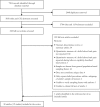Beliefs about back pain and pain management behaviours, and their associations in the general population: A systematic review
- PMID: 29984553
- PMCID: PMC6492285
- DOI: 10.1002/ejp.1285
Beliefs about back pain and pain management behaviours, and their associations in the general population: A systematic review
Abstract
Previous mass media campaigns have aimed to influence how people manage back pain, with mixed success. Campaigns should target beliefs which are related to the behaviours they aim to change. This systematic review brings together research that has measured the prevalence of beliefs about back pain in the general population and factors associated with these beliefs, including future pain-related outcomes. Five databases were searched up until April 2017. Quantitative studies which reported a measure of agreement with a belief about back pain, cross-sectional associations, or associations between beliefs and future outcomes were eligible. Eligibility was assessed and data extracted independently by two authors. Results were tabulated and narratively synthesized. Nineteen studies from 10 countries were eligible (median study n [IQR] = 990.5 [524.75-2387.5]). Beliefs were measured using eight questionnaires and 57 stand-alone items. Beliefs about back pain's negative consequences were common across countries and populations, whereas most samples did not hold fear-avoidance beliefs. Beliefs about back pain's consequences were associated with pain and disability, but only one study investigated this specific relationship prospectively. No studies investigated whether beliefs are associated with future pain management behaviours. Agreement with certain beliefs (e.g. about negative consequences) was associated with sociodemographic characteristics (e.g. older age) and poorer self-rated health. Interventions may benefit from targeting beliefs about the perceived negative consequences of back pain in these populations. However, future research should explore how beliefs prospectively influence the management of back pain. SIGNIFICANCE: This review brings together studies which have assessed the prevalence of beliefs about back pain, and factors associated with holding them. It highlights that whether or not these beliefs represent important determinants of how people manage pain remains unknown.
© 2018 The Authors. European Journal of Pain published by John Wiley & Sons Ltd on behalf of European Pain Federation - EFIC®.
Figures




References
-
- Baird, A.J. , Haslam, R.A. (2013). Exploring differences in pain beliefs within and between a large nonclinical (workplace) population and a clinical (chronic low back pain) population using the pain beliefs questionnaire. Phys Ther 93, 1615–1624. - PubMed
-
- Beales, D. , Smith, A. , O'Sullivan, P. , Hunter, M. , Straker, L. (2015). Back pain beliefs are related to the impact of low back pain in baby boomers in the Busselton Healthy Aging Study. Phys Ther 95, 180–189. - PubMed
-
- Bostick, G.P. , Schopflocher, D. , Gross, D.P. (2013). Validity evidence for the back beliefs questionnaire in the general population. Eur J Pain 17, 1074–1081. - PubMed
-
- Bowey‐Morris, J. , Davis, S. , Purcell‐Jones, G. , Watson, P.J. (2011). Beliefs about back pain: Results of a population survey of working age adults. Clin J Pain 27, 214–224. - PubMed
Publication types
MeSH terms
Grants and funding
LinkOut - more resources
Full Text Sources
Other Literature Sources
Medical
Miscellaneous

